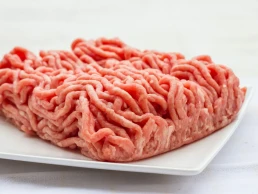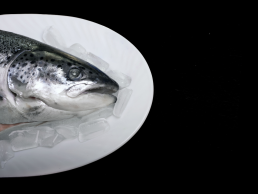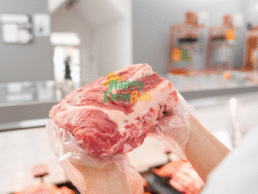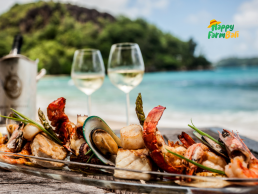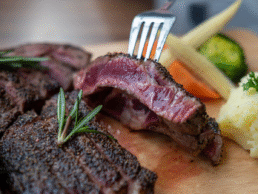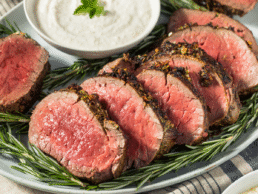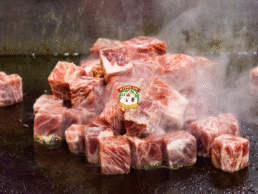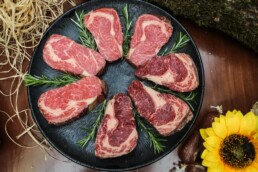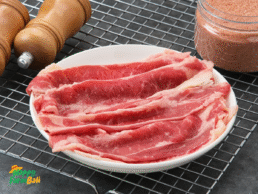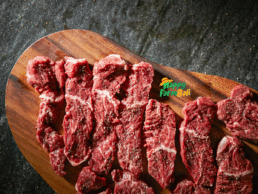What is Mince Beef? A Complete Guide to Cook Beef Mince
What is Beef Mince?
Mince beef, also known as beef mince, is finely chopped or ground beef commonly used in various dishes worldwide. It is made by passing beef cuts through a meat grinder, resulting in small, uniform pieces that are easy to cook and absorb flavors well. Depending on the cut of beef used, mince beef can have varying fat content, with lean options containing less fat and regular versions having a richer taste due to higher fat content. It is a versatile ingredient found in cuisines ranging from Italian pasta dishes to Asian stir-fries.
One of the key factors to consider when buying mince beef is its fat percentage, which affects the texture and flavor of the dish. Lean mince beef, often labeled as 90% lean or more, is ideal for health-conscious meals, while standard minced beef, with around 80% lean meat, is perfect for juicier dishes like burgers and meatballs. Additionally, fresh minced beef should have a bright red color and a firm texture, indicating quality and freshness. It is best stored in the refrigerator and consumed within a few days or frozen for longer shelf life.
Cooking with mince beef is simple and efficient, making it a staple for quick and hearty meals. It can be browned and crumbled for use in tacos, casseroles, and sauces or shaped into patties for burgers and meatloaf. Seasoning plays a crucial role in enhancing its flavor, with ingredients like garlic, onions, herbs, and spices commonly added. Proper cooking techniques, such as draining excess fat when necessary and avoiding overcooking, help retain its tenderness and juiciness. Whether in traditional dishes or creative new recipes, mince beef remains a popular and essential ingredient in home cooking.
How to Make a Mince Beef Product?
 Making a mince beef product involves selecting quality beef, grinding it to the desired texture, and shaping it into various forms for cooking. The process begins with choosing fresh beef cuts, such as chuck or sirloin, which offer a good balance of meat and fat for flavor and tenderness. The beef is then trimmed of excess fat and sinew before being passed through a meat grinder, where it is finely chopped into small, uniform pieces.
Making a mince beef product involves selecting quality beef, grinding it to the desired texture, and shaping it into various forms for cooking. The process begins with choosing fresh beef cuts, such as chuck or sirloin, which offer a good balance of meat and fat for flavor and tenderness. The beef is then trimmed of excess fat and sinew before being passed through a meat grinder, where it is finely chopped into small, uniform pieces.
Once the beef is minced, it can be seasoned with salt, pepper, herbs, and spices to enhance its flavor. Depending on the desired product, the mince beef can be shaped into patties for burgers, formed into meatballs, or used as a filling for dishes like tacos and lasagna. Some recipes may require additional ingredients, such as breadcrumbs and eggs, to improve texture and binding.
The final step is cooking the mince beef product according to the intended dish. It can be pan-fried, grilled, baked, or simmered in sauces, ensuring it is cooked thoroughly to a safe internal temperature. Proper handling and storage of mince beef are essential to maintain freshness and prevent contamination. Whether making homemade burgers or savory meat sauces, minced beef is a versatile ingredient that can be adapted to various recipes.
Beef Mince Product

Beef mince products come in various types based on fat content and intended use. Lean mince beef, typically containing 90% lean meat and 10% fat, is ideal for health-conscious recipes like stir-fries and tacos. Regular minced beef, with around 80% lean meat, is juicier and works well in burgers, meatballs, and meatloaf. Some variations include seasoned or pre-mixed mince beef , which may contain herbs, spices, or breadcrumbs for added flavor and texture.
There are countless delicious recipes that use mince beef as a key ingredient. Classic dishes like spaghetti Bolognese, shepherd’s pie, and homemade hamburgers showcase its versatility. For a healthier option, lean beef mince can be used in stuffed bell peppers or lettuce wraps. Asian-inspired dishes, such as mince beef stir-fry or dumplings, highlight the ingredient’s adaptability. Proper seasoning with garlic, onions, and fresh herbs enhances the flavor, making it a staple in home and restaurant cooking.
Mince beef products are widely available in supermarkets, butcher shops, and online stores. They are sold fresh, frozen, or vacuum-sealed for extended shelf life. Many brands offer organic or grass-fed options, catering to consumers looking for high-quality, ethically sourced meat. When purchasing beef, checking the fat percentage, color, and expiration date ensures freshness and quality. With its affordability and ease of use, mince beef remains a popular choice in households and food industries worldwide.
Mince Beef Supplier in Bali
Mince beef suppliers play a crucial role in Bali’s food industry, providing high-quality mince beef to restaurants, hotels, and households. With the island’s thriving culinary scene, the demand for fresh and reliable beef mince is high, especially among businesses that specialize in Western, Asian, and fusion cuisine. A good supplier ensures that the beef is sourced from trusted farms, processed hygienically, and delivered fresh to maintain its quality and taste. Whether for small local eateries or high-end resorts, a dependable beef mince supplier is essential to meet the diverse needs of Bali’s food market.
One of the best options for sourcing premium mince beef in Bali is Happy Farm Bali. This supplier is known for offering high-quality, fresh, and ethically sourced beef, catering to both individual consumers and businesses. Happy Farm Bali provides a variety of beef mince options, including lean and regular cuts, ensuring that customers get the right product for their culinary needs. With a commitment to sustainable farming and hygienic processing, they guarantee fresh and flavorful mince beef that enhances the quality of any dish.
In addition to quality, Happy Farm Bali also prioritizes excellent customer service and reliable delivery. Their products are available for direct purchase at their farm or through online orders, making it convenient for restaurants and home cooks to access top-grade mince beef . By choosing a reputable supplier like Happy Farm Bali, businesses and individuals in Bali can ensure they are getting fresh, high-quality beef mince that meets their culinary and ethical standards.
5 Reasons Why Frozen Salmon is a Smart Choice
Frozen Salmon Product
Frozen Salmon, What is Frozen Salmon? Frozen salmon is a salmon product that is frozen immediately after harvest to maintain its quality, freshness and nutritional value. This freezing process is done using modern technology such as flash freezing, which allows the fish to freeze in a short time without damaging its natural texture or flavor. In this way, frozen salmon is a practical alternative for those who want to enjoy high-quality fish without having to buy it fresh every day. The product is available in various forms, such as fillets, steaks, or small pieces, which makes it easy to use in household kitchens and culinary industries.
Just like fresh salmon, frozen salmon contains nutrients that are very beneficial for health. It is known to be rich in omega-3 fatty acids, which are good for heart, brain and skin health. In addition, frozen salmon also contains high-quality protein, vitamin D, vitamin B12, and various minerals such as selenium and phosphorus. Since the freezing process is done quickly after the fish is harvested, the nutritional content is maintained, making it a practical and healthy option to support daily nutritional needs.
Frozen salmon products have several advantages that make them popular among consumers. Aside from its longer shelf life compared to fresh salmon, it is also more practical to store in the freezer without compromising its quality. Freezing also allows for wider distribution, so that quality salmon from certain waters can be enjoyed by consumers in different regions. With prices that are often more affordable than fresh salmon, frozen salmon is an ideal solution for consumers who want to get quality fish without having to worry about freshness or availability.
5 Factors Why Frozen Salmon is So Popular on the Market
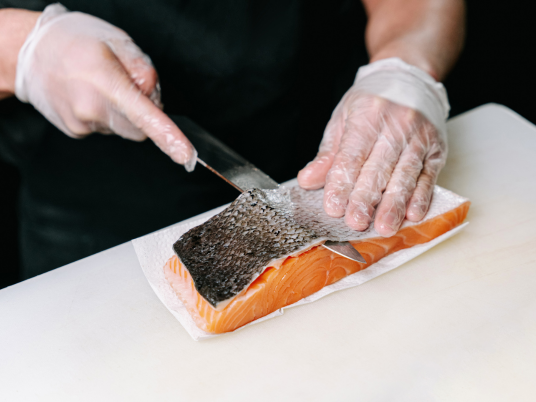 This is a clear discussion of the 5 factors why frozen salmon is popular on the market:
This is a clear discussion of the 5 factors why frozen salmon is popular on the market:
1. Quality Maintained by Fast Freezing Technology
Salmon frozen uses flash freezing technology, which allows the fish to be frozen immediately after harvest. This process locks in the freshness, flavor, texture, and nutritional content. This technology keeps the salmon as fresh as freshly harvested salmon, even after months of storage. Consumers can experience the premium quality of this product, even if it comes from a location far from where the fish originated.
2. Long-lasting and Portable Storage
One of the main reasons frozen salmon is popular is its much longer shelf life compared to fresh salmon. Frozen fish can be stored in the freezer for several months without any loss of quality, making it easy for consumers who want to have high-quality ingredients on hand at any time without being limited by time. This flexibility is especially helpful for consumers with busy lifestyles or who live in areas where it is difficult to get fresh fish in person.
3. Easily Storage and Processing
Frozen salmon products are usually available in various convenient forms, such as fillets, steaks, or small pieces. This provides convenience for consumers to choose according to their needs, whether for cooking daily meals, parties, or special dishes. Frozen salmon is also packaged with vacuum technology, which maintains optimal fish quality during storage. The thawing process is simple, just leave it in the refrigerator overnight or immerse it in cold water.
4. Affordable Price
Compared to fresh salmon, frozen salmon products are generally more affordable due to their distribution and storage efficiency. Freezing allows fish to be transported in bulk to different regions without the risk of spoilage. Thus, consumers can enjoy high-quality salmon at a more competitive price. This factor makes frozen salmon a top choice for many people, from households to culinary businesses.
5. Product Safety and Variety
The ultra-low temperature freezing process helps reduce the risk of bacterial and parasitic contamination, making frozen salmon a safer option for consumption. In addition, the variety of products available in the market is also an attraction. Consumers can find frozen salmon with various options, such as organic, sushi-grade, and seasoned or smoked salmon. This diversity meets the needs of various tastes and cooking styles, from simple dishes to gourmet cuisine.
Benefits of Frozen Salmon
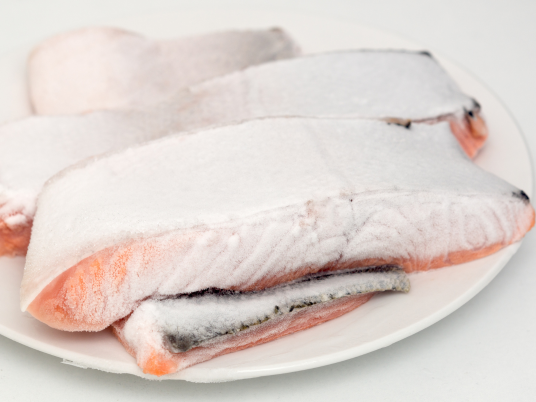 Guaranteed Freshness with Flash Freezing
Guaranteed Freshness with Flash Freezing
One of the main advantages of frozen salmon is its preserved freshness thanks to flash freezing technology. This process is done immediately after the fish is harvested, thus locking in the flavor, texture, and nutritional content such as omega-3, protein, and vitamin D. With this method, frozen salmon has almost the same quality as fresh salmon, even after a long period of storage. Consumers can enjoy high-quality fish anytime without worrying about deterioration.
Long Shelf Life and Practicality
Another advantage of frozen salmon is its much longer shelf life compared to fresh salmon. It can be stored in the freezer for up to several months without any loss of quality, making it an ideal choice for food supplies. In addition, frozen salmon is often packaged in convenient portions, such as individual fillets or steaks, making it easier for consumers to store and use only as needed, reducing food waste.
Ease of Processing and Flexibility of Use
Frozen salmon also excels in terms of ease of processing. With a variety of shapes such as fillets, steaks, or small pieces, this product is very flexible to be processed into various types of dishes, from simple home cooking to gourmet menus. The defrosting process is also easy, simply by gently thawing in the refrigerator or using cold water. These advantages make frozen salmon a practical choice for consumers with busy lifestyles who still want nutritious and quality food.
Trusted Frozen Salmon Supplier
A trusted frozen salmon supplier offers products that are not only high in quality but also consistent in delivery and service. They usually have an extensive distribution network with state-of-the-art cold storage systems, ensuring the product reaches the consumer without any loss of quality. Some suppliers also offer flexibility in ordering, such as a choice of salmon sizes and shapes to suit consumer needs, ranging from fillets, steaks, to small pieces. With a good reputation and commitment to quality, trusted suppliers are important partners for households, restaurants and other culinary businesses.
Trusted salmon suppliers have several characteristics that set them apart from others. One of the main ones is an official certification, such as HACCP (Hazard Analysis Critical Control Point) or ISO 22000, which guarantees that their products are processed and stored according to international food safety standards. They also use flash freezing technology to maintain the freshness, flavor and nutritional content of the salmon, so the product remains high quality even if it is stored for a long time. In addition, trusted suppliers usually provide transparent information about the origin of the fish, harvesting methods, as well as production and expiration dates, so consumers can be assured of quality and safety. One of the best salmon distributors in Bali is Happy Farm Bali.
Happy Farm Bali is one of Indonesia's most trusted frozen salmon suppliers who prioritizes the quality and freshness of their products. Using quick-freezing technology, they ensure that every piece of salmon remains fresh, delicious and nutrient-rich when it reaches the consumer. Happy Farm Bali also maintains high standards in the storage and distribution process, using airtight packaging to maintain product quality. Their wide range of frozen salmon options, such as fillets and steaks, make them a favorite choice for households and culinary businesses.
The Best Bali Meat Distributor 2025
Meat Distributor
Bali Meat Distributor - Bali, an exotic Indonesian island known as a world-class tourist destination, also has a fast growing culinary industry. In recent years, the demand for high-quality food ingredients, especially meat, has increased along with the many new restaurants, cafes, and hotels that have been established. As such, the role of Bali Meat Distributor has become very important in maintaining the quality and supply of meat across the island. For culinary and hospitality businesses, finding a reliable meat distributor is key to maintaining customer satisfaction and preserving the quality of their dishes.
As the main meat distributor in Bali, Best Bali Meat Distributor provides various types of meat, ranging from beef to other processed products that meet food safety standards. Unlike other meat distributors, they are committed to providing fresh and high-quality products sourced directly from selected farms. This not only meets the needs of the local market, but also adheres to international standards that ensure that the products provided are safe, healthy, and of premium quality.
Not only serving restaurants and hotels, Bali Meat Distributor has also started to venture into the retail market, providing products to local people who are looking for quality food ingredients for daily consumption. With the increasing trend of cooking at home, more and more people are interested in finding quality products that are easily accessible. Meat distributors like Bali Meat Distributor help fulfill this need by providing quality and affordable meat. By doing so, Bali Meat Distributor not only supports the culinary industry in Bali but also contributes to improving the quality of life of local communities.
Important Role of the Beef Distributor
 In the culinary and hospitality industry, the existence of a reliable meat distributor plays a very important role. Meat distributors are not only in charge of providing meat supplies, but also maintaining the quality and safety of the products that will be consumed by end customers. In the midst of increasing demand for high-quality food products, Bali meat distributors have become key partners for restaurants, hotels, and supermarkets in ensuring that the raw materials they serve come from trusted sources and meet strict quality standards.
In the culinary and hospitality industry, the existence of a reliable meat distributor plays a very important role. Meat distributors are not only in charge of providing meat supplies, but also maintaining the quality and safety of the products that will be consumed by end customers. In the midst of increasing demand for high-quality food products, Bali meat distributors have become key partners for restaurants, hotels, and supermarkets in ensuring that the raw materials they serve come from trusted sources and meet strict quality standards.
Professional meat distributors understand that maintaining the quality of meat, from the processing process to the delivery to consumers, is a top priority. Good quality meat not only affects the taste of the dishes, but also the health of the consumers. Therefore, meat distributors generally work with farms or producers that implement sustainable and ethical farming practices. In addition, they also conduct strict inspections, starting from the slaughtering, packing, and shipping processes, to ensure that the meat that reaches consumers remains fresh and high quality.
In this modern era, the role of Bali meat distributors is expanding with special demands from consumers, such as organic meat, antibiotic-free meat, or meat with environmentally friendly animal husbandry. Meat distributors that are able to meet these market demands are the first choice for culinary businesses that want to offer superior products to their customers. In addition, distributors that are flexible in dealing with changing market needs are also able to support the sustainability of the culinary business and provide added value to its customers. Thus, the role of meat distributors is essential not only in maintaining product quality but also in responding to evolving market needs.
Considerations to Make When Choosing a Best Distributor for Culinary Business
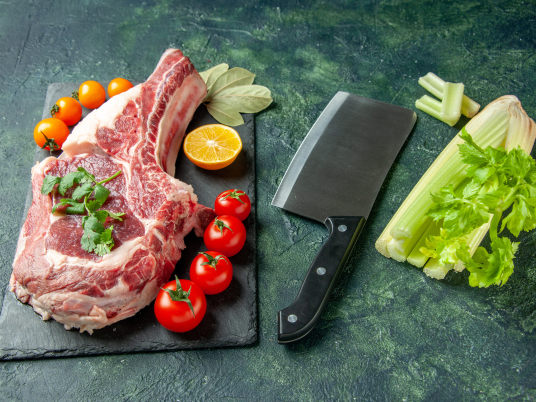 Choosing the best distributors for culinary business is an important step that will affect the overall quality and success of your business. One of the key considerations is the quality of the raw materials offered by the distributor. The quality of raw materials, especially meat, vegetables and other fresh produce, has a huge impact on the taste and healthiness of the food served. Make sure the distributor has high quality standards and is able to guarantee consistent quality over time. Not only that, it is also important to check whether the distributor has certifications that guarantee product safety and hygiene, such as food safety certificates from relevant agencies.
Choosing the best distributors for culinary business is an important step that will affect the overall quality and success of your business. One of the key considerations is the quality of the raw materials offered by the distributor. The quality of raw materials, especially meat, vegetables and other fresh produce, has a huge impact on the taste and healthiness of the food served. Make sure the distributor has high quality standards and is able to guarantee consistent quality over time. Not only that, it is also important to check whether the distributor has certifications that guarantee product safety and hygiene, such as food safety certificates from relevant agencies.
In addition to quality, the distributor's ability to provide raw materials consistently is also an important factor to consider. Distributor reliability in delivering products on time as needed greatly affects the smooth operation of the culinary business. When raw materials arrive on time and in good condition, kitchen operations can run smoothly without any interruption. It's best to choose a distributor that has a reliable and flexible logistics system in handling changes in orders or sudden needs. Thus, the risk of delays or shortages of raw materials can be minimized, and the business can continue to operate smoothly.
Then, also consider the price factor and long-term partnerships with distributors. Competitive pricing is certainly important, but quality should not be sacrificed just for the sake of lower costs. Look for distributors who provide prices in line with quality and can become long-term partners to support your business growth. A good partnership with a distributor can provide many benefits, such as ease of price negotiation, additional support in terms of product promotion, or special discounts for certain orders. By choosing suitable and reliable Bali meat distributor, your culinary business will have a strong foundation to continue to grow in the midst of intense market competition.
Best Bali Meat Distributor 2025
In the culinary industry, finding a reliable meat distributor is one of the main keys to maintaining quality and customer satisfaction. As a highly sensitive raw material, meat requires proper handling from animal selection, slaughtering process, storage, to delivery. A good Bali meat distributor must meet high standards of hygiene, quality and food safety to ensure that the meat remains fresh and fit for consumption until it reaches the kitchen. Choosing a trusted meat distributor also helps culinary businesses meet customer expectations for the quality of taste and healthiness of the food served.
In Bali, one of the most reputable Bali meat distributors is Happy Farm Bali. Happy Farm Bali is committed to providing high-quality meat with a wide selection of products, ranging from beef to other processed meats. The meat provided by Happy Farm Bali is carefully processed through stages that ensure quality and safety. They have strict standards in animal selection and meat processing, so restaurants and culinary businesses in Bali can rely on them as a source of quality meat. For business owners who want to maintain their reputation and the quality of their dishes, Happy Farm Bali is an option worth considering.
In addition to the quality of their products, Happy Farm Bali also offers convenience in terms of delivery and customer service. With an organized and responsive logistics system, they are able to guarantee that their meat supplies arrive on time and in top condition. This flexibility is very helpful for culinary businesses, especially when there are sudden needs or large orders. With experience and commitment to quality, Happy Farm Bali is a top recommendation as a trusted meat distributor in Bali that can be relied upon to support the success of a culinary business.
Seafood Supplier for Your Culinary Business in Bali
Seafood Supplier
Seafood Supplier - With waters rich in various types of fish, shrimp, squid, and shellfish, seafood is one of the most popular dishes for local and international tourists. For culinary businesses in Bali, maintaining the quality of seafood means ensuring that the raw materials used are always fresh and of high quality. This is where the role of seafood suppliers becomes very important to support the smooth operation of the culinary business.
A trusted seafood supplier can ensure a good and high-quality supply, which in turn has a significant impact on the reputation of the restaurant or culinary business. Restaurants that serve seafood must use ingredients that are not only freshly harvested, but also meticulously processed. This way, entrepreneurs can deliver on client expectations and offer the best quality of taste, especially in Bali where perfection is highly valued.
One of the keys to running the best culinary business in Bali is choosing a quality seafood supplier. Some important things to consider include product quality, dependability of the supply chain, and commitment to the environment and hygiene standards. Talking about how to find the best seafood supplier in Bali for your culinary business and what to consider in choosing a partner in order to continue running the business at the highest level.
Fresh Seafood Products
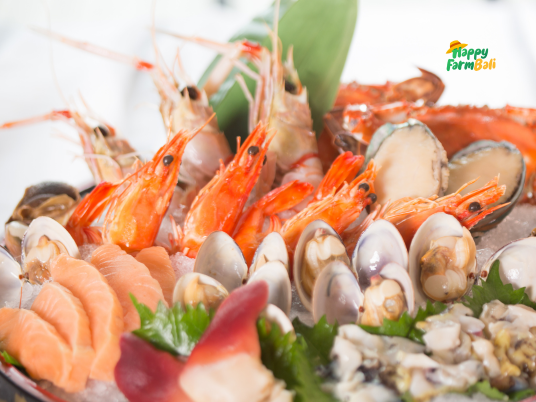 Fresh seafood is seafood that is caught or harvested and immediately sold or consumed without going through the freezing process. This type of seafood includes a wide variety of fish, shellfish, squid, shrimp and crab that are still in their natural, fresh and unprocessed state. The process of managing fresh seafood products usually involves refrigeration with ice or storage in low temperatures to maintain its quality, flavor and texture. These products are often in demand by consumers who want to experience the authentic taste of seafood.
Fresh seafood is seafood that is caught or harvested and immediately sold or consumed without going through the freezing process. This type of seafood includes a wide variety of fish, shellfish, squid, shrimp and crab that are still in their natural, fresh and unprocessed state. The process of managing fresh seafood products usually involves refrigeration with ice or storage in low temperatures to maintain its quality, flavor and texture. These products are often in demand by consumers who want to experience the authentic taste of seafood.
One of the main advantages of fresh seafood products is their superior flavor quality. Products that do not go through freezing have a softer texture, more authentic flavor and distinctive aroma compared to frozen seafood. Chefs and foodies often prefer fresh seafood because it provides a more natural eating experience, especially when prepared in minimal ways such as grilling or sashimi. With fresh seafood, freshness is an important point that directly affects the final result of the dish.
Apart from taste, another advantage of fresh seafood is that its nutritional content remains intact. Seafood is rich in protein, omega-3 fatty acids, vitamins and minerals. In its fresh state, these nutrients do not degrade as they might in frozen or processed products. This makes fresh seafood a healthier option for consumers who want to maintain their optimal nutritional intake. In addition, fresh seafood has a lower risk of quality deterioration as it does not go through a lengthy freezing process.
Frozen Seafood
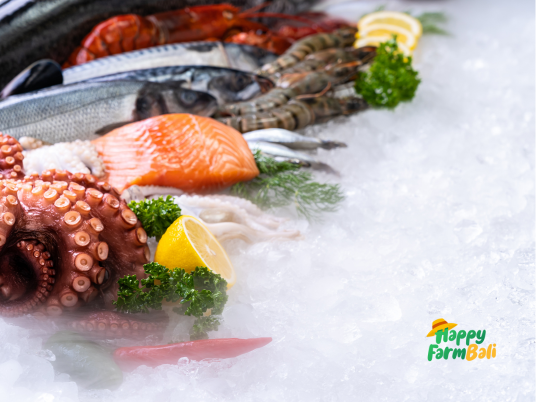 Frozen seafood is a seafood product that is frozen just before marketing to maintain its freshness. The freezing process is done quickly after being caught or harvested to preserve the nutritional value, flavor and texture of the seafood. Freezing aims to slow the growth of microorganisms and prevent food spoilage so that products can be stored longer than fresh seafood products.
Frozen seafood is a seafood product that is frozen just before marketing to maintain its freshness. The freezing process is done quickly after being caught or harvested to preserve the nutritional value, flavor and texture of the seafood. Freezing aims to slow the growth of microorganisms and prevent food spoilage so that products can be stored longer than fresh seafood products.
Some examples of frozen seafood products commonly sold in the market include salmon, tuna, shrimp, squid, cuttlefish, crab and scallops. Frozen salmon is often sold in fillet form, while tuna is available in chunks or steaks. Shrimp and crab are usually packaged in raw or cooked form, depending on your needs. Squid or cuttlefish are also widely available in cleaned rings or whole pieces. These products are very popular because they can be used in a variety of dishes without having to worry about off-season availability issues.
Basically, frozen seafood products have several advantages. Starting from the quick freezing process, it can retain nutrients such as protein, omega-3, and minerals contained in seafood, in other words, almost the same as fresh products. Then, frozen seafood is very beneficial as a food supply, because it is easy to store for a longer period of time. It is also safer from bacterial contamination than fresh products because it has undergone hygienic processing and storage. Frozen seafood also allows access to a wide variety of seafood throughout the year, even if it is not in season.
Bali Seafood Supplier
Seafood suppliers Bali play an important role in maintaining the seafood supply chain, both for local businesses and the tourism industry. With many restaurants, hotels and culinary businesses in Bali, the demand for quality seafood continues to increase. Suppliers will be responsible for providing fresh and frozen seafood products, including fish, shrimp, squid, crab, and more, in the best conditions. They also establish close relationships with fishermen and distributors in order to offer the best quality products and comply with hygiene standards.
Bali itself has long been recognized as an international tourist destination. The center of the crowd will be directly proportional to the number of demands from the culinary business for the main raw materials. Both large and small culinary businesses require seafood suppliers who are not only able to maintain product quality but also supply consistency. A reliable supplier should have a wide, strong distribution network and adequate storage facilities. The goal is to ensure that the seafood they provide remains fresh and nutritious until it reaches consumers. They also often offer fast delivery services to ensure products arrive in optimal conditions, especially for culinary businesses that require fresh raw materials every day.
Happy Farm Bali is one of the best seafood suppliers in Bali that comes highly recommended. They provide a wide selection of high-quality seafood, both fresh and frozen, such as salmon, tuna, shrimp, squid, and crab. With a commitment to freshness, Happy Farm Bali guarantees that every seafood product they offer is processed and stored with strict hygiene standards. In addition, they are also renowned for their fast and friendly service, as well as their ability to cater to the needs of a wide range of customers, from households to Bali's top restaurants. Happy Farm Bali is the ideal choice for anyone looking for the best seafood products at competitive prices.
Seafood Supplier for Bussines
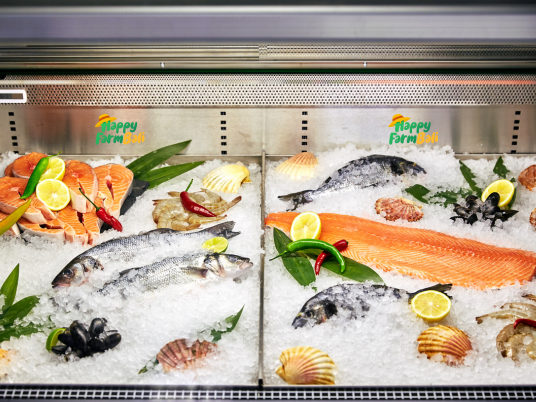 Seafood suppliers in Bali play an important role in supporting the culinary business, especially fresh seafood. The quality and freshness of their products greatly affect the taste of the dishes served. Close cooperation between suppliers and culinary businesses is key in maintaining a stable, high-quality supply and ensuring seafood availability.
Seafood suppliers in Bali play an important role in supporting the culinary business, especially fresh seafood. The quality and freshness of their products greatly affect the taste of the dishes served. Close cooperation between suppliers and culinary businesses is key in maintaining a stable, high-quality supply and ensuring seafood availability.
In Bali, seafood suppliers play a role in ensuring fast and efficient distribution, especially since seafood must be consumed fresh. They must have a strong logistics network to keep the product in the best condition until it reaches the kitchen. Many suppliers offer additional services such as product processing or cleaning to ease operations. Thus, seafood suppliers are strategic partners for culinary businesses that want to maintain high standards in serving seafood.
For culinary businesses that prioritize seafood quality and freshness, Happy Farm Bali is the best answer. They offer a variety of fresh seafood directly from trusted sources, ensuring a consistent and high-quality supply. With professional service and prompt delivery, Happy Farm Bali helps culinary businesses maintain high standards in serving the best seafood. Contact Happy Farm Bali for a great seafood culinary cooperation experience!
Sirloin Beef: The Right Choice for the Perfect Steak
What is Sirloin Beef?
Sirloin beef is one of the most popular cuts of beef in the culinary world, especially among steak lovers. This meat comes from the back of the cow, specifically in the area of the back near the hip, making it a perfect blend of lean meat with a bit of surrounding fat. This combination creates a texture that is dense yet tender, as well as a rich and savory flavor when cooked. It's no wonder that sirloin is often the top choice, both in fine dining restaurants and in home cooking.
The specialty of sirloin beef lies in its ability to adapt to various cooking techniques. Starting from being grilled, stir-fried, to being made into steak, sirloin is able to maintain the natural flavor of the meat well. The presence of fat on its edges also adds a distinctive and juicy flavor, providing a satisfying dining experience. With a relatively more affordable price compared to tenderloin, sirloin offers premium quality that can be enjoyed by various groups.
The popularity of sirloin beef is also accompanied by its high nutritional value. The nutritional and vitamin content makes this meat not only delicious but also healthy. Not only that, sirloin is also easy to find in various places, from traditional markets to modern supermarkets with a range of prices, making it easy for consumers to choose and enjoy it. All these reasons make sirloin the star of the dining table, regardless of the occasion or atmosphere.
Benefits of Sirloin Beef
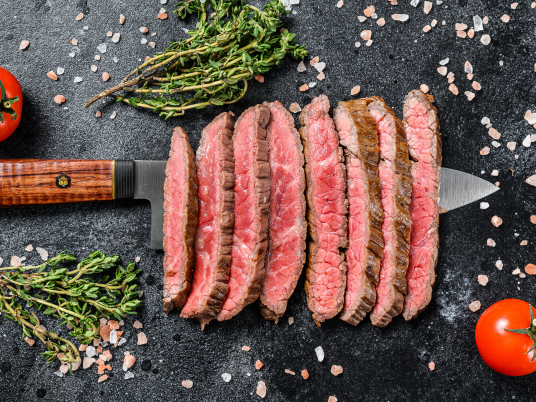 Sirloin beef has a number of advantages that make it one of the most popular parts of beef. One of its main advantages is the perfect blend of dense texture and the presence of fat on the edges. This fat not only enriches the flavor, but also provides natural moisture when cooked. This makes sirloin juicy and savory, especially when cooked into steaks or grilled. In addition, sirloin is suitable for various levels of doneness, from rare to well-done, without losing its succulence, giving meat lovers the flexibility to adjust to their individual tastes.
Sirloin beef has a number of advantages that make it one of the most popular parts of beef. One of its main advantages is the perfect blend of dense texture and the presence of fat on the edges. This fat not only enriches the flavor, but also provides natural moisture when cooked. This makes sirloin juicy and savory, especially when cooked into steaks or grilled. In addition, sirloin is suitable for various levels of doneness, from rare to well-done, without losing its succulence, giving meat lovers the flexibility to adjust to their individual tastes.
In addition to flavor and texture, sirloin also excels in terms of accessibility and price. It is relatively more affordable than other premium cuts, such as tenderloin, but still offers satisfying quality. Not only that, sirloin is also easy to find in various places, from local markets to modern supermarkets. Another advantage is its versatility in processing; this meat can be used for a variety of dishes, such as steak, satay, stir-fry, and even Indonesian specialties. Combined with its high protein, iron and vitamin B content, sirloin is not only a treat for the palate but also provides good health benefits for the body.
The best way to serve sirloin beef is by simply grilling it or cooking it on a hot pan (pan-searing) to retain its natural savory flavor. Before cooking, sirloin should be marinated with a simple mixture of olive oil, garlic, black pepper and a pinch of salt to enrich the flavor without losing its original character. Make sure the pan or grill is really hot so that the outside of the meat can be seared slightly, creating a crispy and delicious caramelized coating. To maintain tenderness, avoid overcooking just a few minutes per side according to the desired level of doneness. Once cooked, let the meat rest for 5 minutes before slicing to lock in the juices, giving a juicy and tender result when eaten. This proves that this type of sirloin beef is best served as a steak.
Sirloin Beef Supplier
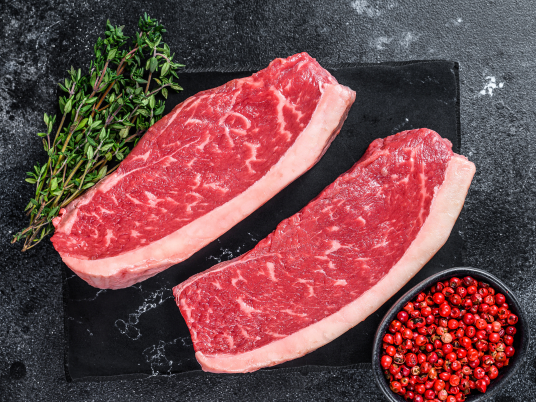 Choosing the right sirloin beef supplier is an important step to ensure optimal quality and flavor. Good suppliers usually offer sirloin beef with precise cuts, fresh texture, and balanced fat content. Make sure the supplier has a good reputation for maintaining product quality, such as ensuring the cold chain is maintained during the distribution process. By choosing a reliable source, consumers not only get the best meat but also safety and convenience when processing it.
Choosing the right sirloin beef supplier is an important step to ensure optimal quality and flavor. Good suppliers usually offer sirloin beef with precise cuts, fresh texture, and balanced fat content. Make sure the supplier has a good reputation for maintaining product quality, such as ensuring the cold chain is maintained during the distribution process. By choosing a reliable source, consumers not only get the best meat but also safety and convenience when processing it.
In addition to product quality, reliable suppliers usually provide a variety of options to suit consumer needs, whether for household use, restaurants, or the food industry. Many suppliers now offer flexible ordering services, including special discounts, vacuum packaging, and direct delivery to your location. This is especially helpful for culinary businesses that require a consistent supply of sirloin beef without compromising on quality. By working with a trusted supplier like Happy Farm Bali, consumers can focus more on the cooking process and creating the perfect dish.
Finding the right supplier requires research to compare several options. Checking customer reviews, quality certifications, and their experience in providing meat products is also necessary. Some suppliers even offer product samples so that consumers can evaluate the quality firsthand. By choosing the best sirloin beef supplier that is committed to quality and service, consumers not only get the best quality sirloin beef but also build long-term trust that can support the success of a meal or culinary business.
Tenderloin Beef: A Cut of Beef That is Popular for its Tenderness
What is Tenderloin Beef?
Tenderloin Beef is a term we often hear, but what exactly is tenderloin? In the culinary world, tenderloin often becomes the main ingredient for luxurious dishes such as filet mignon steak and beef wellington. Because of its tenderness, tenderloin is best cooked using quick techniques such as roasting or grilling. Its distinctive taste and texture make tenderloin a favorite choice for meat lovers around the world.
Tenderloin beef itself is a cut that comes from the back, specifically along the side of the spine below the rib area. This cut is known for its extraordinary tenderness, due to the position of the muscle which is rarely used by the cow. The texture of beef tenderloin is very smooth, without much fat or connective tissue, which is what makes its texture and flavor so special. This cut tends to be small, elongated, and is one of the most sought-after parts of beef in the market, placing it in the premium meat category with a higher price compared to other cuts.
Flavor and Texture of Tenderloin Beef
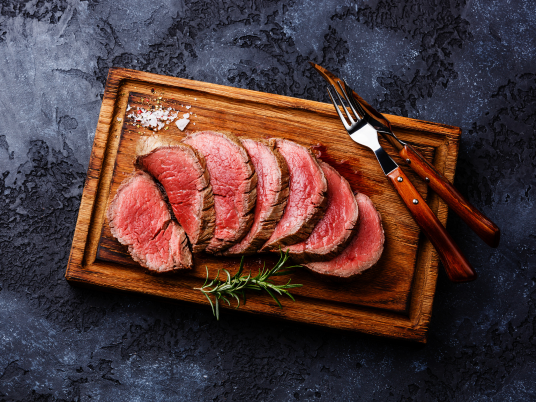 Tenderloin beef has a lighter flavor with less meat and fat compared to other cuts like ribeye. But why is that? Why is the tenderloin beef so tender and delicious? This is because the beef tenderloin cut is located in the animal's loin area and is a muscle that is rarely used during the animal's lifetime. Unlike the muscles that are frequently used in the legs and shoulders, which are rich in connective tissue, the tenderloin experiences little pressure and minimal load-bearing activity. As a result, fewer collagen fibers are produced, which are responsible for the tough texture of the meat.
Tenderloin beef has a lighter flavor with less meat and fat compared to other cuts like ribeye. But why is that? Why is the tenderloin beef so tender and delicious? This is because the beef tenderloin cut is located in the animal's loin area and is a muscle that is rarely used during the animal's lifetime. Unlike the muscles that are frequently used in the legs and shoulders, which are rich in connective tissue, the tenderloin experiences little pressure and minimal load-bearing activity. As a result, fewer collagen fibers are produced, which are responsible for the tough texture of the meat.
Besides its low collagen content, beef tenderloin is also very lean. Intramuscular fat, commonly referred to as marbling, can significantly affect the texture and flavor of the meat. While extensive marbling is highly valued in certain cuts, the lower level of marbling in the tenderloin is part of what makes it tender. The lack of intramuscular fat contributes to the buttery-soft texture that makes the tenderloin highly desirable.
The proper meat aging process will enhance the tenderness of the tenderloin. During the aging process, natural enzymes will break down muscle fibers, thereby improving the texture of the meat. Tenderloin also benefits from this process. When the enzymes work, the result is a steak that melts in your mouth.
Tenderloin VS Sirloin
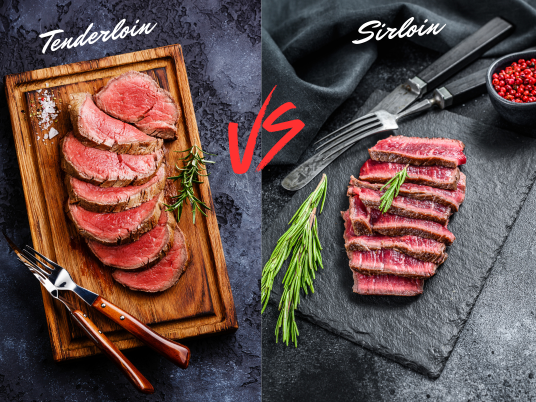 Tenderloin vs sirloin are two popular cuts of beef, but they have different characteristics and uses in the culinary world. Tenderloin beef, which comes from the lower back of the cow along the spine, is known as the most tender cut of meat. The muscles in the tenderloin are rarely used, making its meat fibers tender and almost fat-free. Meanwhile, the sirloin comes from the back of the cow, near the hip, with a firmer texture and slightly more fat compared to the tenderloin. Sirloin has a rich flavor thanks to its fat, although it is not as tender as tenderloin in terms of texture.
Tenderloin vs sirloin are two popular cuts of beef, but they have different characteristics and uses in the culinary world. Tenderloin beef, which comes from the lower back of the cow along the spine, is known as the most tender cut of meat. The muscles in the tenderloin are rarely used, making its meat fibers tender and almost fat-free. Meanwhile, the sirloin comes from the back of the cow, near the hip, with a firmer texture and slightly more fat compared to the tenderloin. Sirloin has a rich flavor thanks to its fat, although it is not as tender as tenderloin in terms of texture.
This difference also affects the cooking and presentation methods of the two cuts of meat. Tenderloin beef is often chosen for luxurious dishes such as filet mignon or beef wellington, where its tenderness is the main attraction. This cut is very suitable for quick cooking techniques such as roasting or pan-searing, as it does not require a long time to achieve maximum tenderness. On the other hand, the more fibrous sirloin is suitable for various cooking techniques, whether grilled, roasted, or cooked at low temperatures for a long time to bring out its flavor and texture. Sirloin is also often used for steak or sliced thinly in dishes like stir-fries.
In terms of price, tenderloin is usually more expensive than sirloin due to its premium texture and limited quantity on the cow's body. Sirloin, with its stronger and more versatile flavor, offers a more economical choice without sacrificing quality. The choice between tenderloin and sirloin usually depends on personal preference, whether one prioritizes exceptional tenderness or a bolder, richer flavor. Both cuts have their own unique qualities and can perfectly meet various culinary needs.
Tenderloin Beef Supplier in Bali
 Bali, as one of the leading culinary tourism destinations, has a high demand for quality meat, including tenderloin. This cut often becomes the main ingredient in various luxurious dishes served in star-rated restaurants and hotels. Tenderloin beef suppliers in Bali must be able to maintain the quality, authenticity, and safety of their products to meet the high standards of the market. High-quality beef tenderloin not only has a tender texture but also must come from well-cared-for cattle and be processed hygienically.
Bali, as one of the leading culinary tourism destinations, has a high demand for quality meat, including tenderloin. This cut often becomes the main ingredient in various luxurious dishes served in star-rated restaurants and hotels. Tenderloin beef suppliers in Bali must be able to maintain the quality, authenticity, and safety of their products to meet the high standards of the market. High-quality beef tenderloin not only has a tender texture but also must come from well-cared-for cattle and be processed hygienically.
One of the standout names among beef tenderloin suppliers in Bali is Happy Farm Bali. Widely recognized for its consistency in providing premium beef, Happy Farm Bali has become the top choice for many restaurants, hotels, and individuals in need of high-quality meat products. The tenderloin they offer comes from cattle raised under the best farming standards and processed with modern technology to ensure the freshness and tenderness of the meat. Not only that, Happy Farm Bali also maintains an efficient distribution chain, ensuring that customers receive fresh and contamination-free meat.
The trust given to Happy Farm Bali is not only due to the quality of their products but also their professional and transparent service. They provide complete information about the origin of the meat, the processing methods, and even storage and preparation tips. With a good reputation and dedication to meeting customer needs, Happy Farm Bali has become one of the most trusted suppliers of beef tenderloin in Bali. This choice is very suitable for professional chefs and culinary enthusiasts who prioritize perfect taste and texture in every dish.
Introduce Premium Cube Meat: Saikoro Beef
What is Saikoro Beef?
Saikoro Beef - In the culinary world, steak has worldwide popularity, with almost every country or region offering its own variations and unique characteristics. American-style thick steak is known for its simplicity in presentation yet remains appetizing, while European steak is often accompanied by rich sauces that are the secret to its deliciousness. Not to be outdone, Asia also has a unique interpretation of steak, creating variants with exotic flavors that captivate its fans. Each version offers unique characteristics that reflect the culinary culture and traditions of its origin.
One of the trending Asian steak variants is the saikoro steak from Japan. This steak uses saikoro beef, cube-shaped cuts of beef resembling game dice, in line with the meaning of the word "saikoro" in Japanese. Its simple yet elegant presentation, combined with small, easy-to-enjoy pieces, makes saikoro steak a favorite among many. Its presence not only reflects the richness of Japanese flavors but also the flexibility of steak to adapt to various regional tastes.
The secret to the deliciousness of saikoro steak lies in the quality of its ingredients. The meat used comes from carefully selected parts of the cow, namely the back, shoulder, and pelvic bone areas. This part is known to have an ideal balance between texture and fat content, resulting in a distinctive tenderness when cooked. With the right cooking techniques, such as grilling over high heat to achieve perfect caramelization, saikoro beef produces a savory taste sensation that melts in the mouth, delighting anyone who tastes it.
What Cut of Meat is Saikoro?
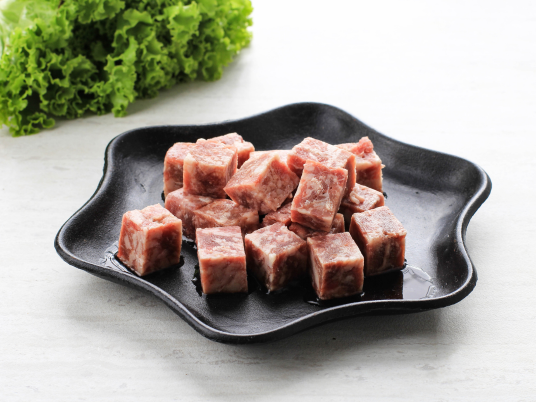 Saikoro steak is unique in the type of beef cut used, which is carefully selected to ensure the best quality and flavor. Saikoro steak is made from high-quality cuts of beef, especially the tenderloin or inner has and sirloin or outer has. The tenderloin is the meat located along the spine to the flank of the cow. This part is known to be very tender as it consists of muscles that are rarely used during the cow's activity, so it has a smooth texture and almost no coarse fibers.
Saikoro steak is unique in the type of beef cut used, which is carefully selected to ensure the best quality and flavor. Saikoro steak is made from high-quality cuts of beef, especially the tenderloin or inner has and sirloin or outer has. The tenderloin is the meat located along the spine to the flank of the cow. This part is known to be very tender as it consists of muscles that are rarely used during the cow's activity, so it has a smooth texture and almost no coarse fibers.
Meanwhile, sirloin is taken from the loin of the cow and has the perfect combination of tender meat with a little fat that gives it a savory taste when cooked. These two parts are chosen for their quality of being able to retain the deliciousness of the beef despite being cooked in a simple way. The selection of tenderloin and sirloin for saikoro steak is not only based on texture, but also ease of processing. The small cubes of these two parts ensure that the meat cooks quickly without losing its tenderness.
The History of Saikoro Beef
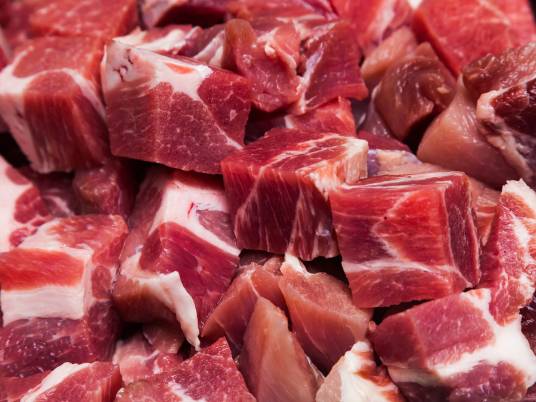 Japan is known for its culinary innovations that always prioritize high-quality ingredients and ease of preparation. Saikoro beef, although it seems modern, is actually part of Japanese culinary tradition that combines practicality with superior taste. This dish has long been known as an alternative way to enjoy beef, different from Western-style steak which requires longer preparation. Saikoro beef, which is cut into small cubes, allows for quick serving of beef without compromising its deliciousness.
Japan is known for its culinary innovations that always prioritize high-quality ingredients and ease of preparation. Saikoro beef, although it seems modern, is actually part of Japanese culinary tradition that combines practicality with superior taste. This dish has long been known as an alternative way to enjoy beef, different from Western-style steak which requires longer preparation. Saikoro beef, which is cut into small cubes, allows for quick serving of beef without compromising its deliciousness.
Japanese saikoro beef is usually sold in ready-to-cook packages, seasoned with salt and pepper, making it easy for consumers to prepare. The cooking method often resembles izakaya steak, a Japanese pub-style restaurant, which offers a relaxed atmosphere for dining and drinking together. This dish is very popular, especially in major cities like Tokyo and Osaka, because it suits the busy modern lifestyle. Its practical and quick serving makes Saikoro beef a popular choice among the urban Japanese population.
Urban dwellers, most of whom are migrants without permanent residences, such as workers living in rented houses or boarding houses, have limited time to enjoy meals leisurely. As a solution, Saikoro beef offers a tender texture, delicious flavor, and ease of serving without the need for further cutting. With various sauce options, this dish becomes the perfect alternative to meet the need for quick, practical, yet delicious meals, in line with the hardworking lifestyle in Japan's big cities.
Bali Saikoro Beef Supplier
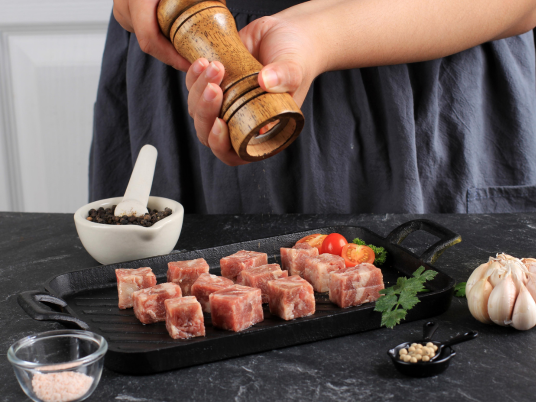 For foodies and restaurateurs in Bali, sourcing quality saikoro meat is an important step to ensure the deliciousness of the dishes served. Since saikoro steak requires perfectly cut and premium quality meat, choosing a reliable supplier is key. With the development of the culinary industry in Bali, there are now more and more meat suppliers offering excellent products to meet the needs of the market, ranging from starred restaurants to small and medium enterprises.
For foodies and restaurateurs in Bali, sourcing quality saikoro meat is an important step to ensure the deliciousness of the dishes served. Since saikoro steak requires perfectly cut and premium quality meat, choosing a reliable supplier is key. With the development of the culinary industry in Bali, there are now more and more meat suppliers offering excellent products to meet the needs of the market, ranging from starred restaurants to small and medium enterprises.
One of the best saikoro beef suppliers in Bali is Happy Farm Bali. As a provider of high-quality meat, Happy Farm Bali offers saikoro beef that is precision-cut to produce uniform cubes, according to international standards. Not only does Happy Farm Bali prioritize the quality of their meat, they are also known for their friendly and professional service, making customers feel comfortable with their transactions. In addition, they ensure that the products offered are fresh, halal, and have gone through a strict quality control process.
For anyone who wants to serve saikoro steak with authentic flavor and perfect texture, Happy Farm Bali is the right choice. With a recognized reputation in Bali, this supplier not only caters to culinary needs but also supports local businesses to thrive through their premium meat products. So, if you're looking for quality saikoro meat for your special meal, Happy Farm Bali is a solution worth considering.
Meltique Saka: The New Innovations of Premium Beef Products
Meltique Beef
Meltique Saka - Meltique Beef has taken the spotlight in the meat industry as an exciting innovation for foodies and hospitality businesses. Different from regular beef, Meltique Beef offers a unique texture and flavor thanks to processing technology that combines tradition and modern innovation. With a special fat injection technique inspired by French cooking methods, Meltique Beef produces consistent marbling or fat patterns throughout the cut, creating a tender sensation and rich flavor when cooked. This makes it an attractive option for chefs and restaurants who want to deliver a premium culinary experience to their customers.
Meltique Beef is growing in popularity as it delivers the benefits of tenderness and balanced flavor without relying on naturally marbled beef, such as Wagyu. Meltique's fat injection technology enables uniform fat distribution resulting in distinctive tenderness without the need for super-premium quality meat. For culinary businesses, this means they can offer meat dishes with high flavor quality without having to spend as much as Wagyu beef, providing added value to customers at a more affordable price.
In addition to its superior flavor and texture, Meltique Beef also has great versatility in processing. It is suitable for a variety of cooking techniques, such as grill, roast, or sous-vide, and is suitable for a wide range of menu types, from premium steaks to fusion cuisine. Because of these advantages, Meltique Beef is now widely chosen by high-end restaurants and casual dining establishments that want to provide a different experience for their diners. Meltique Beef's innovation not only opens up new opportunities in the world of commerce, but also elevates the culinary standard of meat to a higher level at a more competitive price. Meltique Saka is a new brand of meltique beef products. So what does this innovative beef look like? Here's the article.
Beef Product Innovation
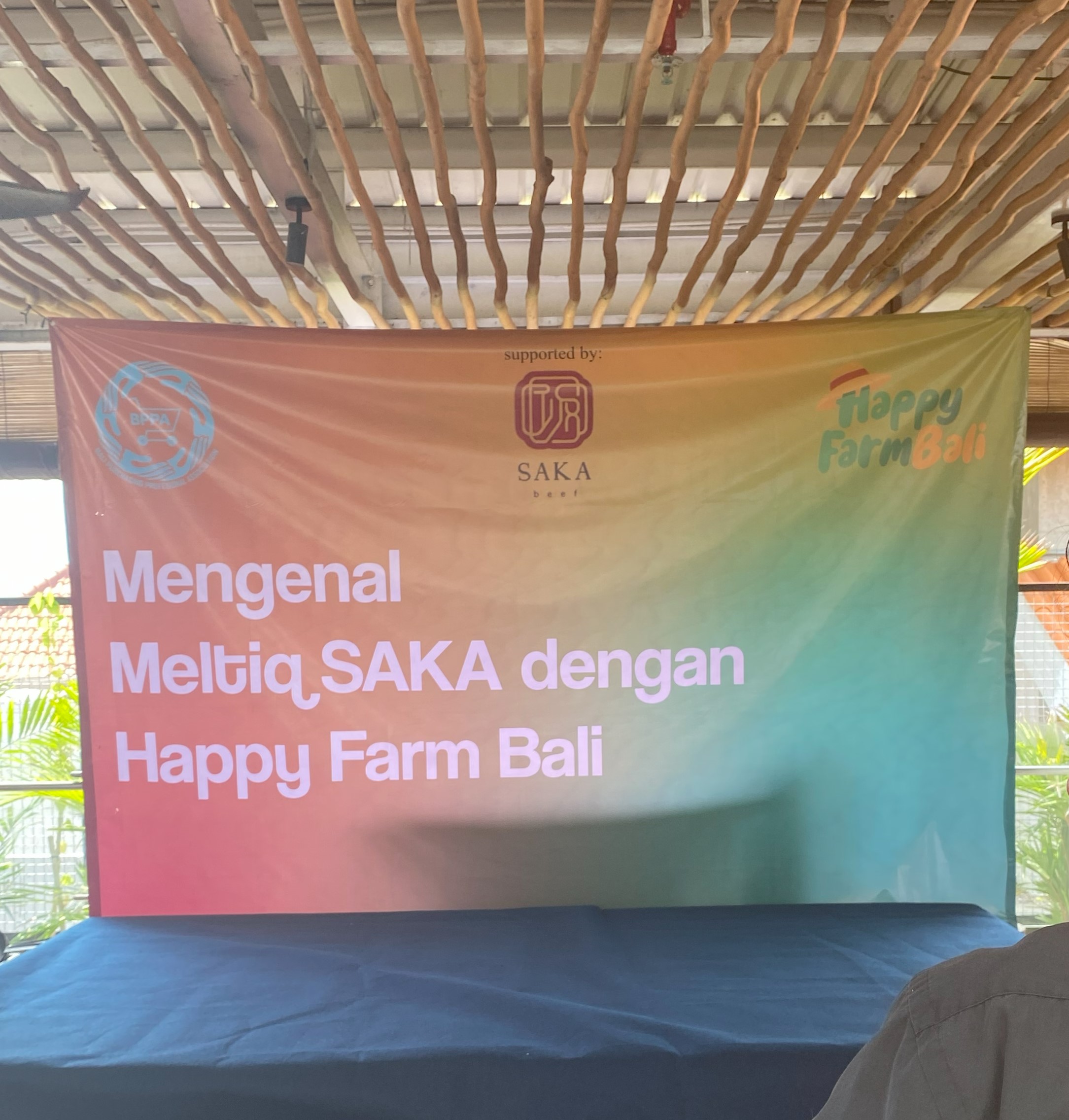 Innovation in meat products has grown rapidly as consumer demand for culinary quality and variety has increased. One of the latest innovations in the meat industry is processing techniques that enrich the flavor and texture of meat without having to rely entirely on a particular breed of cattle. Various techniques, such as smoking, aging, and fat regulation, are now being implemented to produce premium quality meat. These innovations allow consumers to experience tender and flavorful meat, even from cuts that were previously considered less premium.
Innovation in meat products has grown rapidly as consumer demand for culinary quality and variety has increased. One of the latest innovations in the meat industry is processing techniques that enrich the flavor and texture of meat without having to rely entirely on a particular breed of cattle. Various techniques, such as smoking, aging, and fat regulation, are now being implemented to produce premium quality meat. These innovations allow consumers to experience tender and flavorful meat, even from cuts that were previously considered less premium.
One popular innovative technique is fat injection technology, which allows for an even distribution of fat in the meat. With this method, the meat can have a marbling or fat pattern similar to that of premium cuts such as Wagyu, resulting in a savory taste and softer texture when cooked. This technique not only increases the market value of meat products, but also provides flexibility for the culinary industry. Restaurants and chefs can serve high-quality menus at more affordable prices, as this technique reduces dependence on certain expensive types of meat.
Meltique Saka is one of the innovative products that applies this technology to provide a new experience in enjoying meat. Using advanced fat injection methods, Meltique Saka is able to deliver meat with stunning texture and flavor, resembling premium meat without the high price. This product is suitable for a variety of preparations, whether grilled, sautéed, or cooked with modern techniques such as sous-vide. Meltique Saka not only fulfills the demand for high-quality meat products, but also becomes a new choice for those who want to enjoy premium meat dishes with a touch of innovation.
Meltique Saka
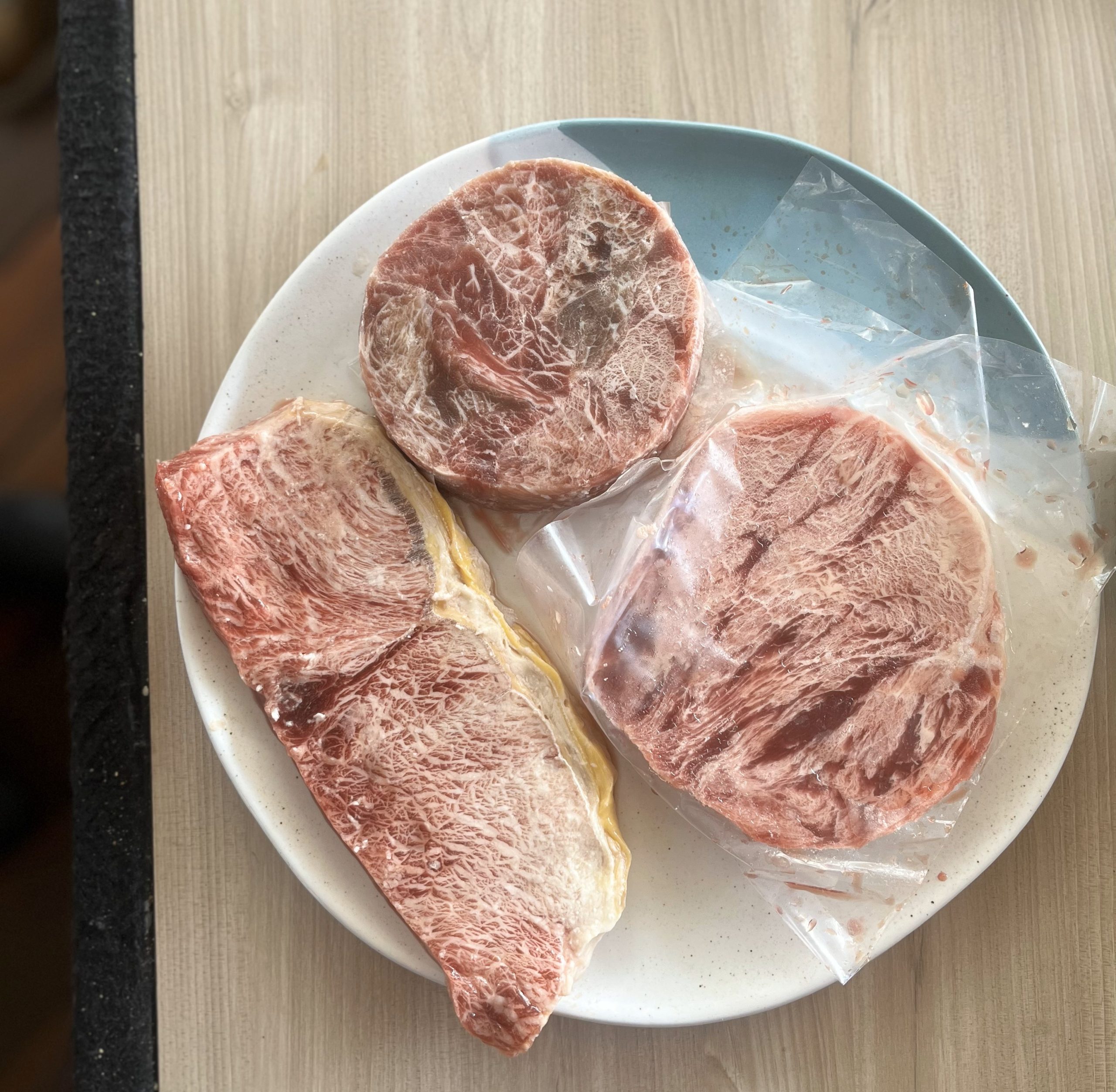 Meltique Saka is an innovative meat brand that brings a premium meat experience at a more affordable price. Using cutting-edge processing technology, Meltique Saka creates a tender meat texture and even fat marbling throughout the cut. This technique is inspired by the French cooking method, which combines quality fat with the cut of meat through a special injection technique, resulting in a rich flavor and juicy texture. This makes Meltique Saka an attractive option for restaurants, hotels, and home consumers who want to serve high-quality meat in a more cost-efficient manner.
Meltique Saka is an innovative meat brand that brings a premium meat experience at a more affordable price. Using cutting-edge processing technology, Meltique Saka creates a tender meat texture and even fat marbling throughout the cut. This technique is inspired by the French cooking method, which combines quality fat with the cut of meat through a special injection technique, resulting in a rich flavor and juicy texture. This makes Meltique Saka an attractive option for restaurants, hotels, and home consumers who want to serve high-quality meat in a more cost-efficient manner.
Meltique Saka meat also offers great versatility in various types of cooking. It is suitable for various techniques, such as grilling, sautéing, and sous-vide cooking. In addition, Meltique Saka is suitable for a variety of menus, be it classic steak, modern satay, or fusion cuisine that combines various flavors. With these advantages, Meltique Saka is widely used by chefs who want a versatile meat product that can produce dishes with consistent flavor and texture. This product helps culinary businesses in creating quality dishes without having to spend high costs.
As a trusted meltique beef brand, Meltique Beef Saka also places priority on quality and safety standards. Its processing process meets various food safety certifications, ensuring that the products that reach consumers are not only delicious but also safe and hygienic. With a commitment to quality and innovation, Meltique Saka has successfully built a reputation as a reliable meltique beef brand, both among culinary industry players and home consumers. Meltique Saka not only fulfills the market's need for premium meat products, but also inspires new, more affordable and exciting culinary options.
Bali Beef Supplier
Bali as a leading culinary destination in Indonesia requires high-quality meat suppliers to support its thriving hospitality, restaurant and catering industries. Meat suppliers in Bali play an important role in ensuring the availability of quality raw materials that are ready to be processed into dishes that satisfy the tastes of tourists and locals. One of the leading meat suppliers in Bali is Bali Beef Supplier, which provides a variety of premium cuts of meat with flexible and reliable services, enabling culinary businesses to meet their meat supply needs in a timely manner. Bali Beef Supplier's commitment to quality and customer service helps culinary businesses maintain the high standards that customers expect.
In the midst of tough competition in the culinary industry, choosing a trusted supplier like Bali Beef Supplier is a strategic step in maintaining quality and business sustainability. Besides Bali Beef Supplier, Happy Farm Bali is also worth recommending as one of the best in providing fresh and quality meat in Bali. With support from suppliers like these, Bali's culinary businesses can continue to deliver exceptional culinary experiences for customers, while helping to enhance Bali's culinary image nationally and internationally.
How to Choose and Cooking Beef Short Plate
Beef Short Plate
Short plate beef is a cut of beef located at the bottom of the rib cage, between sirloin and brisket. This cut is famous for having a lot of marbling, which gives it flavor and tenderness when cooked. Short plate is commonly used in a variety of dishes, from steaks to barbecue, and is often the base for signature dishes such as bulgogi or carne asada. The delicacy and rich flavor of this meat make it highly desirable to culinary enthusiasts.
To properly prepare beef short plate, it is important to pay attention to the cooking method. Techniques such as grilling or braising are highly recommended, as they bring out the natural flavors and deliciousness of this cut of meat. Before cooking, the meat should be marinated to enhance the flavor, and the grilling or slow cooking process will help to tenderize the meat fibers, resulting in a tender and delicious dish. With the right processing, short plate meat can be an appetizing and satisfying dish.
Sliced Meat Production Process
The process of making sliced meat into market-ready beef short plate starts with the selection of quality raw materials. Cattle farmers usually select cattle with superior genetics and good feeding to produce marbling-rich meat. Once the cattle reach the ideal age and weight, they are slaughtered in a slaughter facility that meets hygiene and safety standards. This process is important to ensure that the meat produced is fresh and of high quality.
After slaughtering, the meat will go through a cleaning and preprocessing process. The short plate meat, located at the bottom of the rib cage, is then separated from the other parts. Experienced personnel will perform the cutting carefully to ensure proper size and shape. Once cut, the meat will be cleaned of excess fat and bones, before being put through a chilling process to preserve its freshness. Refrigeration also helps to improve the texture of the meat, making it more tender when cooked.
After the cooling process, the beef short plate is ready to be marketed. Before being sold, the meat will usually be neatly packaged, either in slices or whole pieces, to attract consumers' attention. Labels on the packaging often include information on the origin of the meat and proper storage methods. With a meticulous process from raw material selection to packaging, short plate meat is ready to meet market demand and pamper the tongues of culinary lovers.
Variety of Beef Short Plate Processions
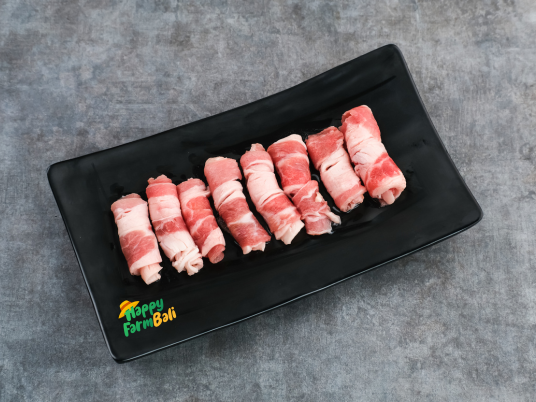 Beef shortplate comes in many impressive varieties, each reflecting the unique culinary cultures of different countries. In Asia, one of the most famous preparations is bulgogi from Korea. In this dish, slices of bee short plate are marinated in a mixture of soy sauce, sugar, sesame oil and garlic, then grilled over high heat. Bulgogi is usually served with rice and a variety of vegetables, and is used as a main dish in various events and celebrations.
Beef shortplate comes in many impressive varieties, each reflecting the unique culinary cultures of different countries. In Asia, one of the most famous preparations is bulgogi from Korea. In this dish, slices of bee short plate are marinated in a mixture of soy sauce, sugar, sesame oil and garlic, then grilled over high heat. Bulgogi is usually served with rice and a variety of vegetables, and is used as a main dish in various events and celebrations.
In Mexico, short-rib meat is the star of carne asada. The meat is seasoned with a combination of spices, such as cumin and paprika, then grilled until browned. Carne asada is usually served in tacos or burritos, with salsa, guacamole and fresh vegetables. The smoky and savory flavor of beef short plate makes it the perfect choice for everyday meals or parties. The variety of flavors and presentation makes this dish very popular among food lovers.
In Western countries, beef short plate is often made into a delicious steak. This cut can be grilled or pan-fried with simple seasonings, such as salt and pepper, to bring out its natural flavors. Short plate steak is also often served with chimichurri sauce or BBQ sauce, which adds a rich dimension of flavor. Aside from steak, the meat can also be used in stew dishes, such as French-style pot au feu, where the meat is slow-cooked with vegetables and herbs to produce a thick, flavorful broth. This variety of preparations shows how versatile short plate meat is, making it a sought-after ingredient in kitchens around the world.
How to Process Beef Short Plate
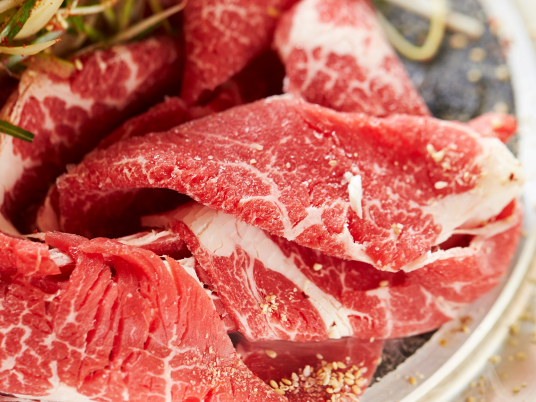
Processing beef short plate in the right way is essential for a delicious and tender result. First of all, choosing the appropriate cooking method will greatly affect the texture and flavor of the meat. Grilling is one of the best ways to prepare short plates, as the high heat brings out the umami flavor and makes the meat juicy. Before cooking, it is important to marinate the meat with a rich seasoning mix, such as soy sauce, garlic, and other spices, so that the meat absorbs the flavors and becomes more tender.
In addition to grilling, the braising or slow cooking method is also very suitable for short plate meat. In this process, the meat is cooked in a liquid, such as stock or sauce, at a low temperature for several hours. This technique helps to soften the fibers of the meat, resulting in a tender and flavorful dish. Before braising, be sure to browning the surface of the meat to give it an additional layer of flavor. Dishes such as pot au feu or stew can be produced this way, where the meat is served with vegetables and a thick broth.
Finally, it is important to pay attention to the cooking time. Short plate meats should not be overcooked to prevent them from becoming tough. For steaks, proper cooking time on each side will ensure the meat stays juicy, while for braising dishes, check the tenderness of the meat periodically. After cooking, let the meat rest for a while before slicing, so that the juices can soak in. By following these steps, you can enjoy the perfect short plate meat, with rich flavors and satisfying textures.
Bali Meat Supplier
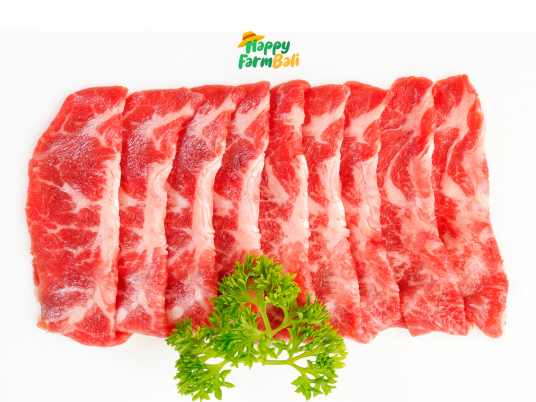
When it comes to choosing quality short plate meat, having a reliable bali beef supplier is essential to ensure the freshness and deliciousness of the product. In Bali, one meat supplier worth considering is Happy Farm Bali. Known for its commitment to quality, Happy Farm Bali provides beef that is well raised and processed to a high standard.
Happy Farm Bali offers a variety of meat cuts, including short plates, which can be used for various culinary preparations. With fast delivery services and neat packaging, customers can easily get fresh meat straight to their doorstep. In addition, they also provide information on how to choose and process the right meat, so you can cook satisfying dishes with confidence. The quality and service provided make Happy Farm Bali an ideal choice for foodies on the island.
With the wide variety of preparations that can be made from short plate meat, finding the right supplier like Happy Farm Bali will help you bring special dishes to the table. By ensuring the quality of the meat, you will not only enjoy the delicacy in every bite, but also be able to share an unforgettable culinary experience with family and friends. So, if you are in Bali and looking for quality meat, Happy Farm Bali is the perfect solution to fulfill your needs.
Premium Meltique Beef New Product Innovation
Premium Meltique Beef
Premium meltique beef is a processed type of beef that mimics the marbling and tenderness commonly associated with premium Wagyu beef. It is made by injecting beef cuts with a mixture of fat and sometimes other ingredients, such as seasoning or binders, to enhance its flavor and juiciness. This method creates a marbling effect similar to wagyu, where the fat is distributed within the muscle, making it tender when cooked. One of the reasons meltique beef is more affordable compared to genuine wagyu is because it uses less expensive cuts of beef and incorporates the injection process to achieve its desired texture and flavor, without the need for expensive breeding, rearing, or feeding methods that wagyu cattle require.
In addition to the discussion on price comparison, to differentiate between premium meltique beef and wagyu, there are a few key indicators. Wagyu has natural marbling that comes from the cattle's genetics and diet, with the fat appearing in thin, intricate streaks throughout the meat. In contrast, the marbling in meltique beef often appears more uniform and artificial due to the injection process, lacking the fine and delicate pattern found in wagyu. Additionally, Wagyu typically has a richer, more buttery flavor, while premium meltique beef, though tender and flavorful, may have a slightly processed taste. When purchasing, premium wagyu often comes with certification indicating its grade and origin, which is not the case for premium meltique beef.
Meltique vs Wagyu
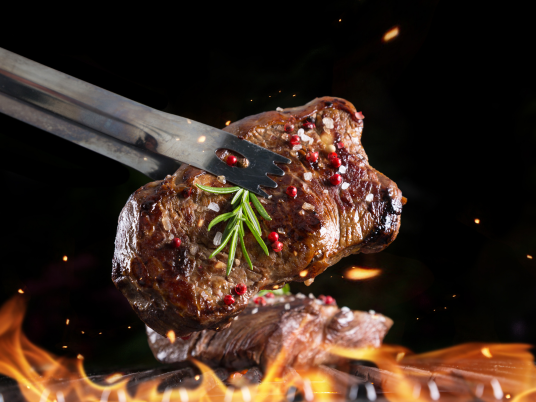 As discussed previously, meltique is different from wagyu. When comparing Meltique vs Wagyu, there are several key differences in aspects such as price, nutrition, preparation, and how they are served. Here's a breakdown of these differences:
As discussed previously, meltique is different from wagyu. When comparing Meltique vs Wagyu, there are several key differences in aspects such as price, nutrition, preparation, and how they are served. Here's a breakdown of these differences:
1. Price
- Premium Meltique Beef: Meltique beef is significantly more affordable than Wagyu due to its manufacturing process. Since it uses regular cuts of beef injected with fat and seasonings to mimic Wagyu’s marbling, the production costs are lower. This makes it an attractive option for restaurants or consumers who want a similar taste experience without the premium price tag.
- Wagyu Beef: Wagyu, particularly high-grade Wagyu like A5 from Japan, is much more expensive. This is because of the specific breed of cattle used, the specialized feeding and rearing practices, and the natural, highly prized marbling that develops over time. Wagyu can be many times more costly than meltique due to these factors.
2. Nutritional Content
- Premium Meltique Beef: Since it’s processed and injected with fat, Meltique beef tends to have a slightly higher fat content compared to regular beef, but it is still less fatty than authentic Wagyu. Some versions may also contain additives, which may not appeal to consumers looking for a natural product.
- Wagyu Beef: Wagyu is known for its rich marbling of unsaturated fats, which are healthier compared to saturated fats. It contains high levels of oleic acid, which is a heart-healthy fat. Though Wagyu is high in fat, it’s generally considered healthier due to the quality of fat and the presence of beneficial nutrients like omega-3 and omega-6 fatty acids.
3. Flavor and Texture
- Premium Meltique Beef: Meltique is tender and juicy due to the injection of fats, but it lacks the depth of flavor that comes from Wagyu’s natural marbling. The fat in Meltique may not melt as evenly as Wagyu's, leading to a slightly less buttery mouthfeel.
- Wagyu Beef: Wagyu is world-renowned for its melt-in-your-mouth texture and rich, buttery flavor. The natural marbling in Wagyu beef, combined with its high-fat content, provides a luxurious eating experience. The fat renders smoothly during cooking, creating a velvety texture that is hard to replicate.
4. Cooking Methods
- Premium Meltique Beef: Meltique can be cooked similarly to regular beef. It is commonly grilled, pan-seared, or used in dishes that require quick, high-heat cooking. It doesn’t need long cooking times since the injected fats keep it moist.
- Wagyu Beef: Wagyu is best cooked delicately to allow the fat to melt slowly and infuse the meat. It’s often served as thin slices or smaller cuts and cooked over low to medium heat. Japanese Wagyu is often prepared as teppanyaki, sukiyaki, or shabu-shabu to highlight the tenderness of the meat. For steaks, it’s recommended to sear Wagyu quickly on both sides and serve it medium-rare to medium.
5. Serving Styles
- Premium Meltique Beef: Meltique is versatile and can be used in various dishes, from steaks to stir-fries and even burgers. Its affordability makes it accessible for casual dining and large servings. It is typically served in Western-style preparations.
- Wagyu Beef: Wagyu is often served in smaller portions due to its richness. It’s frequently featured in fine dining or special occasion meals. In Japan, Wagyu is sometimes served raw (as sushi or sashimi) to fully appreciate its texture, while Western-style Wagyu steaks are usually served simply with minimal seasoning to let the quality of the meat shine.
Meltique beef offers an affordable alternative to Wagyu, with its fat-injection process creating a tender and juicy experience. However, it lacks the natural, luxurious marbling and depth of flavor found in Wagyu. Wagyu, particularly high-grade Japanese Wagyu, is a premium product with a rich taste, superior nutritional profile, and high-fat content that provides a melt-in-the-mouth texture, which justifies its higher price. Each type of beef caters to different consumer needs, from everyday meals to gourmet dining.
Is Meltique Beef Safe to Serve?
 Meltique beef is generally safe to serve, but it's important to understand what it is and how it's prepared to ensure proper handling. Premium meltique beef is a type of processed meat where a blend of fats, typically beef fat and other oils, is injected into the muscle tissue of the meat to enhance its tenderness and flavor. The process mimics marbling, giving the beef a richer texture similar to high-quality cuts like wagyu.
Meltique beef is generally safe to serve, but it's important to understand what it is and how it's prepared to ensure proper handling. Premium meltique beef is a type of processed meat where a blend of fats, typically beef fat and other oils, is injected into the muscle tissue of the meat to enhance its tenderness and flavor. The process mimics marbling, giving the beef a richer texture similar to high-quality cuts like wagyu.
As with any meat product, food safety depends on proper storage, cooking, and hygiene. Premium meltique beef should be refrigerated or frozen until ready to cook, and it must be cooked to an appropriate internal temperature to eliminate the risk of bacteria like E. coli or salmonella. Cooking Meltique beef to medium-rare or above (with an internal temperature of around 145°F or 63°C) is usually recommended to ensure it's safe for consumption.
Also, since it's processed with added fats, some people with dietary restrictions or sensitivities to additives may want to check the ingredients used. But for most, Premium meltique beef is safe, provided it's handled and prepared properly.
Meltique Beef Supplier
Bali Meltique Supplier is a premier meat supplier that specializes in high-quality beef products. Known for its premium cuts and exceptional flavor, Meltique has established a reputation for sourcing cattle raised in optimal conditions. This commitment to quality ensures that their beef is not only tender and juicy but also rich in taste, making it a favorite among chefs and culinary enthusiasts. With a focus on sustainability and ethical farming practices, Meltique delivers products that meet the highest standards in the industry.
Happy Farm Bali is a prominent player in Bali's culinary scene, recognized for its dedication to providing fresh, locally sourced ingredients. As a proud distributor of premium meltique beef, Happy Farm Bali ensures that their customers have access to the finest meat products available. The farm prioritizes quality and sustainability, fostering strong relationships with local farmers to bring the best of Bali's agricultural offerings to the market. This focus on local sourcing not only supports the community but also enhances the freshness and flavor of their products.
In an exciting development, Happy Farm Bali has recently launched a new beef product called Meltique SAKA, touted as the only one of its kind in Bali. This exclusive offering combines the exceptional quality of premium meltique beef with unique flavor profiles, appealing to the discerning tastes of both locals and tourists. With the introduction of Meltique SAKA, Happy Farm Bali aims to elevate the dining experience on the island, making it a must-try for anyone seeking the best in gourmet beef. This innovative product is set to redefine the culinary landscape of Bali, attracting food lovers eager to explore new and exquisite flavors.

